 We are doing home automation project in that we need snubber for both resistive and inductive load. If we connect less than 5W load(Bulb) it is keep on glowing without switch on. Whether i need to design a snubber for Low Watts? If so, Please Suggest the corresponding formula for design a snubber for different value of loads. Thanks.
We are doing home automation project in that we need snubber for both resistive and inductive load. If we connect less than 5W load(Bulb) it is keep on glowing without switch on. Whether i need to design a snubber for Low Watts? If so, Please Suggest the corresponding formula for design a snubber for different value of loads. Thanks.
- 91
- 4
- 10
-
I think it is a good idea to add a simple circuit diagram to your question, so it is absolutely clear what you are looking for. – jippie Nov 06 '13 at 09:47
-
Also please briefly explain how this question is different from http://electronics.stackexchange.com/questions/87685/will-snubber-pass-voltage-thourgh-it to prevent others from voting them duplicate. – jippie Nov 06 '13 at 09:48
-
@jippie Sir i have attached my schematic – kalis Nov 06 '13 at 10:24
1 Answers
One of the problema with RC snubbers is that they leak current. This doesn't really matter if the leakage current is much lower than the load requires to work, but otherwise it does. In the circuit diagram in the question there is a 10nF capacitor in series with the load. If we neglect the load and the series resistor, at 50Hz this capacitor acts as a
\$X_{capacitor}=\dfrac{1}{2\pi f C} = \dfrac{1}{2\pi × 50 × 10\cdot 10^{-9}} \approx 300\text{k}Ω\$
impedance which in series with your 5W bulb:
\$R_{load} = \dfrac{U^2}{P} = \dfrac{230^2}{5} \approx 10 \text{k}Ω\$
apparently allows enough current to make it glow. It actually is a bit more complicated than that, with phase angles and all, but we're talking order magnitude to get a feeling for what is happening. Therefore it is important to size the snubber for the attached load.
Notice: This also implies that a snubber in parallel with a relay switch does not fully switch off the load and leathal voltages may be present even when switched off!
I did find rule of thumb design guideline in a book, but I have no practical experience with these guidelines:
Design guidelines:
Resistor:
- 1Ω per Volt power supply rail voltage;
- Sufficient power rating (eg. 2W).
Capacitor:
- 0.1μF per Ampère power supply current;
- Voltage rating in accordance with power supply voltage.
An unrelated practical example:
I once built a snubber network 22nF/630V and 100Ω/0.5W for switching a small PC amplifier rated at 240V(AC) and 70mA. That configuration did solve the problem I was facing back then even though it doesn't exactly follow the above design guidelines.
- 33,033
- 16
- 93
- 160
-
I would personally appreciate if someone was able to underpin these (or similar) design guidelines with the related theory. – jippie Nov 06 '13 at 10:24
-
R=U^2/P≈10kΩ in this what is the u^2. i dont understand this formula sir – kalis Nov 06 '13 at 12:49
-
U is commonly used for voltage in Europe and we usually have 230V(AC) for mains power. – jippie Nov 06 '13 at 12:55
-
sir, your answer very use full for us. we design a snubber for 5w load through your guidance now it doesn't glow that much level. you told that RC snubber is they leak current, is there any possible to stop that leakage current completely or not? – kalis Nov 15 '13 at 05:36
-
Using a parallel (with the switch) RC will always leak current when using an AC system. I am not aware of any viable alternatives for a simple RC snubber in this situation, but then again I don't know everything. The only exception is when you have a pure resistive load, then you can skip the entire snubber network. – jippie Nov 15 '13 at 07:41
-
-
Sir, we have one more doubt, If we connect the snubber circuit for resistive and inductive load means 5V to 6V present in the load always even when it is switched off. This small leak voltage create any problem in future? and it will be reduce life time of the load? – kalis Nov 18 '13 at 11:07
-
Don't know for your load. I've never heard of issues other than a slight power consumption. This is another reason for carefully designing a snubber for the load. As noticed in my previous comment, if you are really concerned about the leakage current, you could consider switching off the snubber with a secondary relay, but you want to make sure the cost you make is reasonable with the 'problem' you try to solve. – jippie Nov 18 '13 at 13:14
-
@jippie - I upvoted your answer because it is helpful, but your math is wrong. The capacitive reactance in your first equation should be 318K, not 30K. – TimH - Codidact May 06 '14 at 20:00
-